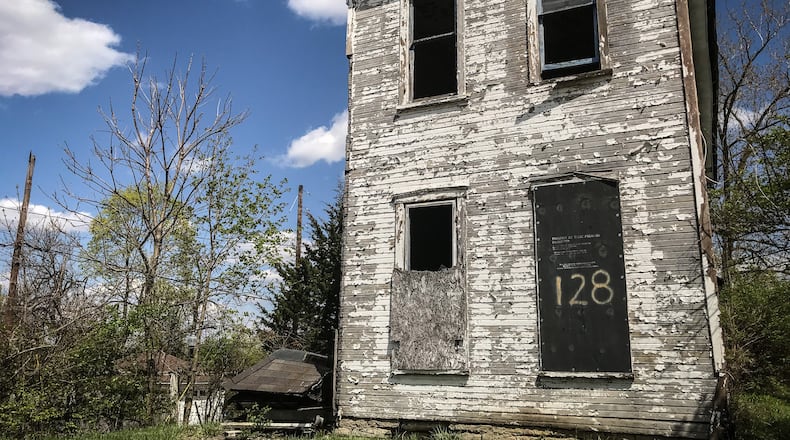Although Dayton has torn down thousands of abandoned and blighted residential properties in the last decade, the city still has one of the highest housing vacancy rates among Ohio’s larger urban areas, according a Dayton Daily News analysis of recently released 2020 Census data.
More than 11,000 housing units across the city sit empty, and some blocks have rows of unoccupied and boarded up homes and apartment buildings.
Dayton was ground zero for the foreclosure crisis, compounding decades of population loss, an aging housing stock and the exit of some major employers.
But Dayton’s vacancy rate has significantly declined, population losses have slowed and officials say the city continues to prioritize blight removal and it hopes to use some of its $138 million in federal rescue funds on demolition.
Blight “is the number 1 issue, as far as I’m concerned,” said Todd Kinskey, Dayton’s director of planning, neighborhoods and development. “We spend a lot of resources boarding buildings, responding to housing complaints ― we know, empirically, that a vacant building does drag down property values.”
Dayton is home to about 68,900 housing units, according to data from the U.S. Census Bureau’s decennial census.
The bureau recently released some of the first local level results from its once-in-a-decade comprehensive count of people and households.
In Dayton, about one in six housing units are vacant (16.2% of the total).
Only two other Ohio cities with populations in excess of 10,000 residents have higher vacancy rates: East Cleveland (25.4%) and Sandusky (16.7%). Nearly 190 cities in the state have more than 10,000 residents.
About 15.7% of housing in Cleveland and 13.3% of housing in Youngstown is vacant.
Cincinnati’s vacancy rate is 12.1%, while Toledo’s is 11% and Canton’s 10.8%. Akron’s rate is 10.3% and Columbus’ 8%.
Trotwood (pop. 23,070) also has a high rate: 14.1% (or about 1,650 empty units).
The Census classifies housing units as vacant if no one was living in them on April 1, 2020, unless the occupants were temporarily absent, like if they were on vacation or a business trip or temporarily hospitalized.
Vacant properties oftentimes become blight, leading to disinvestment that jeopardizes the long-term health of neighborhoods, said Michael Grauwelman, executive director of the Montgomery County Land Reutilization Corporation, also known as the land bank.
“Vacancies among other things lead to the erosion of wealth for neighboring property owners, loss of viable moderately priced housing stock and introduces a cost to local government that cannot be recaptured,” he said.
Dayton’s high vacancy rate is largely due to legacy issues such as aging housing stock, outmigration, disinvestment and the loss of manufacturing and good-paying jobs, Grauwelman said.
The foreclosure crisis certainly played a role too, he said, and Dayton was especially hard hit by the bursting of the housing bubble and its aftermath.
Some officials say Dayton is still “right-sizing” its housing supply after decades of bleeding population.
Dayton lost nearly 3% of its population in the last decade.
City leaders, however, say that is a win because because Dayton lost about 15% of its population between 2000 and 2010 and about 9% in the preceding decade.
Dayton’s significant population loss in past decades certainly contributed to housing vacancies, Kinskey said, but the city’s population is stabilizing, which is very encouraging.
Dayton’s vacancy rate was 21% in 2010, which also was one of the highest levels in the state.
Since then, however, the number of vacant units in the city has decreased by 29%.
Following the housing crash and the Great Recession, Dayton received millions of dollars in state and federal funds for demolition and neighborhood stabilization.
Using this funding, the city demolished thousands of homes and multifamily buildings, including some of the worst eyesores.
These funding sources mostly dried up, but some leftover funds have become available and the city still puts some of its general fund and Community Development Block Grant money toward demolition.
Also, the city hopes that it can use some of its $138 million in federal rescue funds on demolition, said Kinskey, with the city.
Preliminary feedback from residents indicates demolition is one of their top priorities for the federal funds, Kinskey said, and annual surveys consistently show that city residents overwhelming support increased blight removal.
The good news is that many vacant housing units and residential structures in Dayton are in decent shape and have rehab and reuse potential, Kinskey said.
The city’s nuisance list only has about 1,000 properties, he said, and some of those are garages and accessory structures. The list generally contains deteriorating properties that are recommended for demolition.
Kinskey said it’s important to note that this Census data show the number of vacant housing units ― not the number of vacant structures.
Some large vacant apartment properties with many units could skew the numbers, he said, especially since the Census count occurred less than a year after the 2019 Memorial Day tornadoes.
Some properties damaged by the tornadoes weren’t torn down until much later, while other residential buildings have been rehabbed and reopened.
The tornadoes likely contributed to Dayton’s and Trotwood’s high vacancy rates, officials said.
The city is expected to benefit from the Montgomery County Land Bank’s program called Demo 2.0, which has about $3 million in leftover Neighborhood Initiative Program funds, said Grauwelman.
The land bank will team up with local communities to tear down blight if they provide a dollar-for-dollar match.
The program helps eliminate obsolete structures, Grauwelman said, and the land bank has another program to “reposition” vacant structures that can be rehabbed.
About the Author



